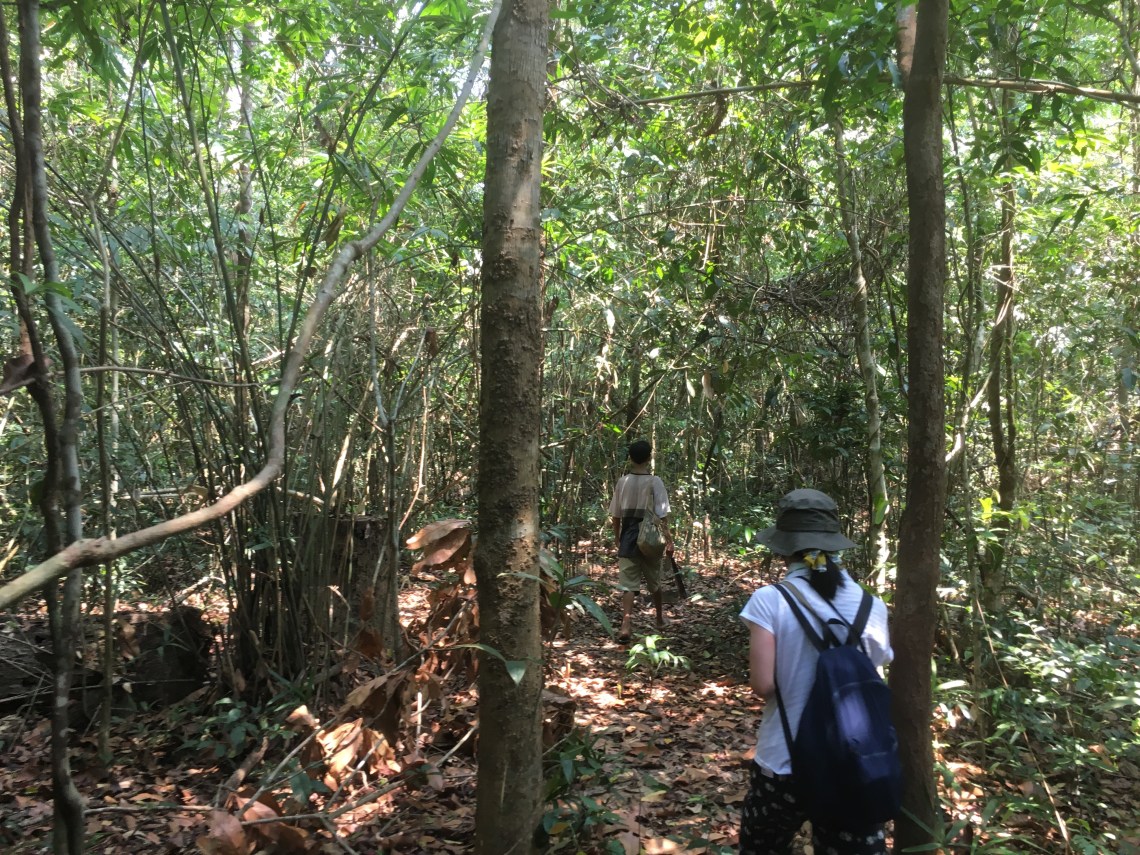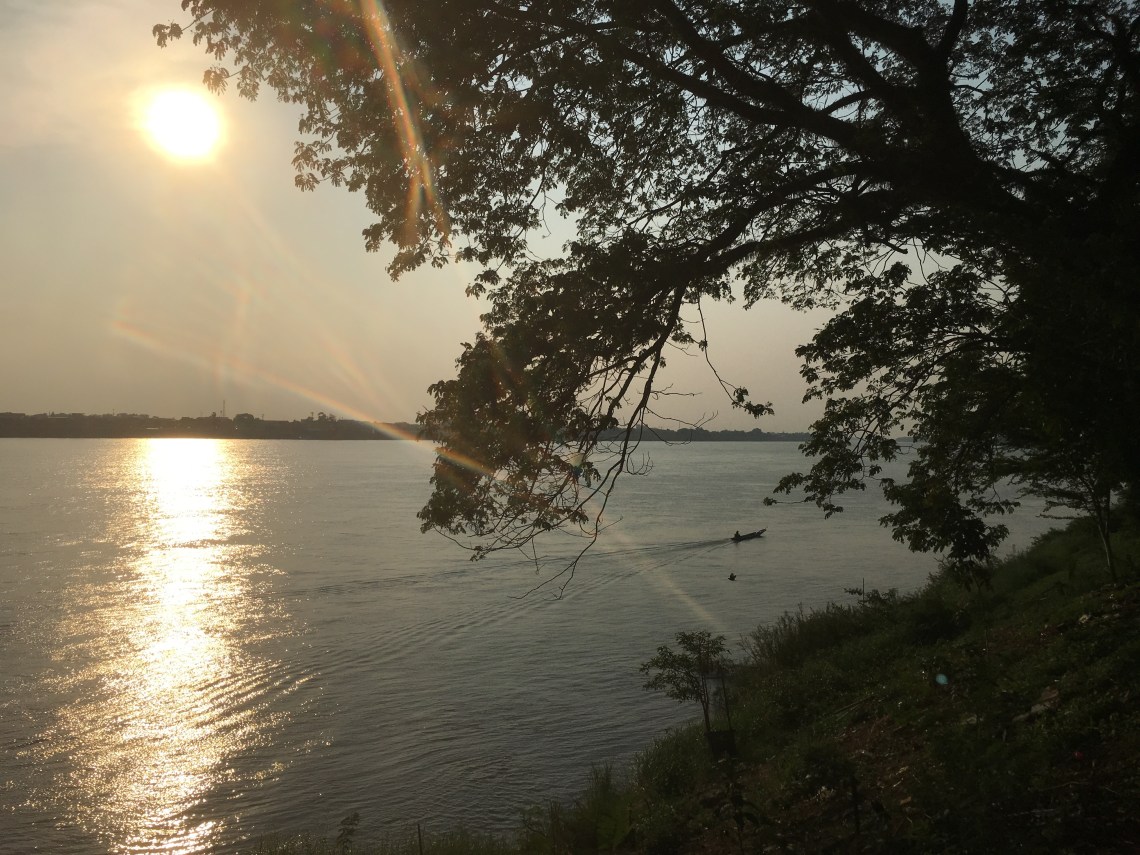We arrive in central Laos; take a jungle hike; visit caves and a mysterious lake; enjoy a Mekong sunset
Thakek | Central Laos
We traveled 8 hours south by bus from Laos’s capital Vientiane to a small town called Thakek on the River Mekong, a base for visiting nearby national parks, long underground caves that swallow rivers, and striking limestone karst scenery.
***
We are keeping well; Laos has been a fabulous and fascinating place so far, and we’re feeling the power of Laotian sunshine. Coping with the 40 degree heat has been the biggest issue given the amount of outdoor activity we’re doing, and we’re finding ourselves having to neck litres of water all the time, just to stay hydrated and slap on the factor 40.
Air-conditioned rooms and buses have been a big help. The only time I don’t like AC is at night as it makes me cough, but the special-beloved-one likes to sleep with the air-conditioning on, so yesterday I decided to wear a hood at night. As I also wear night-shades, yesterday she thought she was in bed with the grim reaper.
***
The town of Thakek itself is a a simple place, a series of crossroads, a water fountain and a tree lined boulevard with a few restaurants on the Mekong riverfront.
I’m running out of adjectives to describe sleepy towns in Laos. Just as soon as we visit a sleepy town, we visit another one, even sleepier. Drowsy? Connotations of taking a substance. Lethargic? Connotations of laziness. Dozey? Connotations of being dim. Somnolent? Too unused. I think I will stick with sleepy, sleepier and sleepiest.
Thakek was sleepier than Luang Prabang but perhaps not the sleepiest town on our trip.
***
A ride down ‘cave alley’
On our first day we rode a scooter 20 km east of Thakek. The limestone scenery is distracting on a ride, it’s so imposing and dramatic. rising out of the land like massive tree-covered monoliths.

We visited Elephant cave which was very quiet and sat in the coolth of Pah Seuam admiring rows of ancient stalactites dripping like ochre organ pipes.

The most interesting cave was Tham Pa Fa called Buddha Cave. About 20 years ago, a certain Mr Nong climbed up a cliff to collect bats (a Laotian meat source); instead he discovered 230 Buddha statues some over one and half millennia old; manuscripts found in Tham Pa Fa were written in a range of scripts, Lao, Khmer, Lanna (northern Thailand near Chiang Mai), and Pali. Today villagers guard the car 24 hours a day.
No photos were allowed inside the cave which was lined with rugs, and lit up with candles and a tube light; incense drifted upwards pushed along by fan. Two guards slumbered. At the end of the cave all the buddhas statues of different sizes stop upright beyond a golden fence.
Jungle trek to a mysterious lagoon.
We hiked a 9 mile trek in a national park (Phou Hin Boun National protected area) because we had read of a mysterious lagoon of clear blue water, whose depth had confounded anyone who had tried to measure it. The lake called Khoun Khong Leng, is a spring-fed lagoon in one of Laos’ 21 protected biodiversity areas.
We started off walking past stilt-houses of Lao village people whose abodes showed many similarities with the Missing people of Majuli we had visited last month in Assam.
We walked through clouds of white butterflies, beyond them rising limestone mountains, till the forest engulfed on us on all sides, strangling the sunlight in to angled shafts.
 The lead guide got his machete out and started hacking the way clear and pointing out obstacles to mind, like tree roots, twigs and little snakes.
The lead guide got his machete out and started hacking the way clear and pointing out obstacles to mind, like tree roots, twigs and little snakes.
The trek in any other climate wouldn’t have been that difficult but it was really hot and humid in the jungle. Either that or I’m just getting really middle aged. As we panted during a rest, our tour guide, Ice, said, ‘Lao people don’t sweat so much.’ In contrast, I could count a drip of sweat from the peak of my cap once every three seconds.

We sat on rocks in a dried river bed for a typical Laotian meal of roasted chicken and pork strips, little red sausages and sticky rice.
We climbed the lower reaches of Elephant Mountain and Ice stopped and asked us to pick up a leaf and a stone. We then placed them on a mound to honour the spirit god of the mountain and Ice explained that in addition to Buddhism, the Lao also believe in spirits called phi.
A brief side-note on religion in Laos: In 1975 when the Communists took over Laos, religion was suppressed (Marx said religion was a drug for the masses); in 1992, Buddhism was allowed again but monks were forbidden to promote spirit worship. Despite this the Lao people still believe in their phi.
After four hours of hiking in the jungle we came to a wide gravel road between dried-out paddy field where a jeep which took us to the lake.
(It’s always feels a little odd when you end a hike with a car that takes you to the end of the hike; it tells you that there’s an easier way to get there. But much of life, I suppose, is about the journey)
It wasn’t quite the ending to the hike I had expected. We had seen pictures of a lagoon in a jungle, like a Bounty Chocolate Bar advert but here was a large pond enclosed by fences. That’s not to say Khoun Khong Leng wasn’t a beautiful lake; it certainly has a mysterious air and a lovely turquoise blue hue. But the trek was the hero for me.
There’s said to be a a spring at the bottom of Khoun Khong Leng and recently some monks dropped a weight to try to measure its depth. They ended up attaching seven 100 metre strings and still couldn’t reach the bottom. A French scuba team tried to dive to the the bottom but were unable to get there because of the strong gushing current.
The two sides of the Mekong River at Thakek
That evening we deserved our beers on the Mekong Riverfront. The West Bank of the river belongs to Thailand and the river here has two very different sides.
Through binoculars (one of the 16 things I alway find useful when travelling) one can make out a few kilometres away on the Thai side, a certain lifestyle difference; shiny white SUVs; golden temples; stupas lit up brilliantly; rows of evenly placed lampposts; shiny shopfronts. In contrast, on our side, there was a dimmer more audited lighting, fewer cars and fisherman in long-tailed boats catching their supper.
There we watched the sun go down, listened to the lapping waves and a drinking game about different ways of procreating from a group of young gap-year girls on the next table.

***
Next stop: to the even sleepier town of Savannakhet.
This post is part of series called 90 Days in South East Asia . It was first published on http://www.heyloons.com and was written while travelling in-country.
All the links to blog posts in the series are as follows:
1) I’m backpacking around Southeast Asia for 90 days
2) Packing for backpacking: 16 useful things to take on your travels
3) How to sleep on a flight (aches on a plane)
5) A storm in an Assamese teacup
6) On the lazy man’s road: the story of Dhodar Ali
7) Digboi, the oil town in the rainforest
8) To Sivasagar: home of the Assamese kings
9) Things to see in Majuli, the world’s largest river island
10) An unexpected treat on the river Brahmaputra
11) Helpful hints on how to climb a 17 foot elephant on your wedding day
13) The Assamese Bihu: a time of unbridled joy
14) A tale of a dry day in India
15) Kalimpong and a magical Himalayan wedding
16) Chiang Mai, a pretty little temple town
17) Replanning our route, re-routing our plan
18) Luang Prabang in Laos: the jewel on the Mekong River
19) A slow and unintended minibus to Vang Vieng
20) In the laid-back city of Vientiane
21) Laos: Caves, a jungle trek and the mysterious turquoise lake
22) On our way down south in Laos
24) Friday night at the Saigon Opera House
26) Vietnam days: Hoi An, Hue and Hanoi
27) Landing in the sea at Halong Bay, Vietnam
29) Bagan, the jewel of Myanmar
30) Three nights on Lake Inle in Myanmar
31) Finding a perfect perfume in Singapore
32) In Borneo, watching the orangutans at play
33) Watching turtles at Selingan Island
***
Loved this post! I read its title and thought to myself, “thank goodness! You can’t be in this area of the world and not explore caves!!! That’d be criminal!” (Of course, in another life I must’ve been a mole. I love it underground! And let’s face it, getting underneath a few hundred tones of limestone is an effective way to beat the heat!).
Well done on the trek. No matter how much water you shed (I still remember our first rainforest trek when the back of my fingers developed beads of sweat!!), I firmly believe that moving through a landscape on foot is the best way to truly get a feel for it! Move through it on foot, struggle through it, have moments of discomfort AND awe, and you will then “get it.” Truly get it. Truly experience it and gain perspective. Truly understand your place in this world.
LikeLiked by 1 person
Hi Sheri. Thank you. You would have been in your element, lots of great routes. I lacked the courage to go too far in to the caves, some of them go on for miles. But yes it’s so nice and cool in the caves and somewhat therapeutic with the dripping noises – no wonder our ancestors considered them prime real estate.
Loved your comment about knowing your place in this world. Mountains, lakes and forests, the ocean they all dwarf us.
LikeLiked by 1 person
Is it still as sleepy when the sun goes down and the temperature with it?
LikeLiked by 1 person
I think as it’s the off peak season it’s really quiet. The tourist season is really in the cooler months November to February.
LikeLiked by 1 person